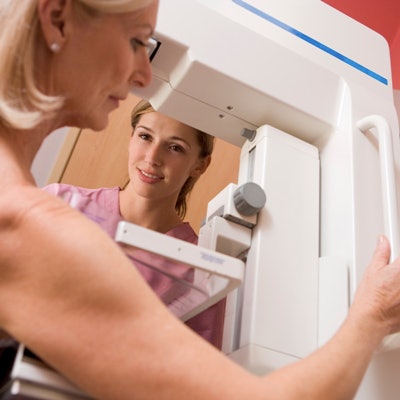
Most screening mammography patients want to know their estimated lifetime risk of developing breast cancer -- and radiologists need to step up to provide this information, according to a study published in the May edition of the American Journal of Roentgenology.
A team of researchers from Massachusetts General Hospital and Moffitt Cancer Center in Tampa, FL, found that 86% of women expressed an interest in knowing their breast cancer risk in great detail. In addition, those with greater than 20% risk wanted to receive this information verbally (AJR, May 2017, Vol. 208:5, pp. 1163-1170).
"When faced with a hypothetical scenario of elevated risk (> 20%), patients were significantly more likely to choose oral communication of results and more detail regarding their level of risk," lead author Dr. Nita Amornsiripanitch and colleagues wrote.
The study findings suggest there may be a missing piece in the breast cancer screening protocol.
"Many breast radiologists may not envision risk assessment as within their purview," the authors wrote. "However, in this era of patient-centered, value-based care, radiologists have an obligation to their patients to improve the appropriate use of supplemental screening modalities, such as MRI ... [and to understand] patient perceptions and preferences regarding communication of their lifetime breast cancer risk at screening mammography."
Capable communication
There are a number of models available to estimate a woman's risk of developing breast cancer, including Gail, Claus, BRCAPro, and Tyrer-Cuzick, the authors noted. Conducting risk assessment may require additional work for a breast imaging facility, but it has the potential to improve cancer detection by increasing the appropriate use of supplemental screening, corresponding author Dr. Bethany Niell told AuntMinnie.com via email.
 Dr. Bethany Niell from Moffitt Cancer Center.
Dr. Bethany Niell from Moffitt Cancer Center."Preliminary or 'screening' risk assessment at the time of screening mammography could be performed in an imaging center using validated risk stratification models," Niell said. "This preliminary assessment would identify women who may benefit from referral to high-risk specialists to undergo more detailed, formal risk stratification. But any facility performing risk assessment must be prepared to provide results appropriately and should be cognizant of how patients wish to receive risk assessment results."
For the study, the researchers distributed an anonymous survey to 1,061 screening and surveillance mammography patients between April and June 2015. They received responses from 503 women. Of these, 84% had no personal history of breast cancer, 59% had no previous breast biopsies, and 79% had no first-degree female relative with breast cancer. The majority (87%) reported annual or biennial screening intervals.
The survey asked women to express their preferences for how they would like to receive risk estimate information and in what level of detail, and it included hypothetical scenarios for patients with and without a more than 20% lifetime estimated risk of breast cancer.
Most survey participants (86%) expressed interest in learning their estimated breast cancer risk, but only 8% had undergone formal risk assessment, the group found. Among the 503 respondents, 50 (10%) expressed no interest in learning about their estimated breast cancer risk; seven of these women had received formal risk assessment before, and 17 had a previous diagnosis of breast cancer. Thirty-four of the 50 patients explained their reason for a lack of interest, with a previous diagnosis being the most common rationale, followed by understanding their lifetime risk due to a family history of breast cancer, advanced age, and anxiety about receiving bad news.
For a hypothetical lifetime risk of less than 20%, survey respondents' preferred method of communication was to be informed by a mailed letter with their mammography results. For a hypothetical lifetime risk of more than 20%, the preferred method was oral communication.
Survey respondents indicated that they would like to learn of estimated breast cancer risk in detail, no matter what their risk, the researchers found. For a hypothetical risk of less than 20%, 64% of survey respondents wanted detailed information, while for a hypothetical risk greater than 20%, 85% of survey respondents wanted detailed information.
"Our results show that women undergoing screening mammography are interested in understanding their lifetime risk of breast cancer, regardless of their level of hypothetical risk," the team wrote.
Next steps
Amornsiripanitch and colleagues offered some suggestions for how to incorporate risk assessment into breast imaging practice:
- Most screening mammography patients will be low risk (less than 15% lifetime risk); send these patients a standard mailed letter with mammography results.
- Women at intermediate (15% to 20%) or high risk (more than 20%) should receive a customized letter along with the mammography results; the letter should state that a risk calculation has been performed and that the patient should meet with a specialist to discuss her level of risk.
- Imaging centers performing risk calculations should have a high-risk clinic to which women can be referred.
- During the clinic consult, women can discuss risk assessment and receive genetic testing recommendations and/or information about strategies such as chemoprevention.
Will an increase in breast cancer risk assessment boost the appropriate use of supplemental screening, or even compliance with annual screening mammography? It's unclear, the authors wrote. Nevertheless, understanding patient preferences for receiving risk assessment information is key.
"As more breast imaging centers are beginning to offer risk assessments ... it is critical that breast radiologists and practice managers at these centers understand the importance of patient preferences for receiving risk assessment results," they concluded.




















